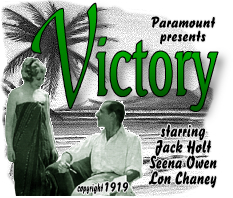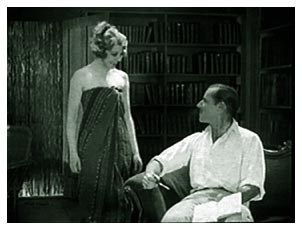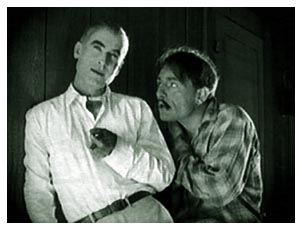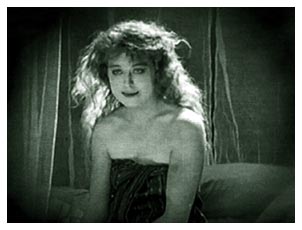

Paramount Pictures
From a story by Joseph Conrad. Directed by Maurice Tourneur
CAST: Jack Holt (Axel Heyst), Seena Owen (Alma), Wallace Beery (Schomberg), Lon Chaney (Ricardo), Ben Deely (Mr. Jones), Bull Montana (Pedro), Laura Winston (Mrs. Schomberg), George Nicholls (Capt. Davidson)
Axel Heyst lives in quiet seclusion on the island of Samburan
in the Dutch West Indies. He follows the philosophy of his father's
writings - "Perfect isolation means perfect peace."
On a trip to Soerabaja to "cut his last links to civilization,
commercial and otherwise," he meets Alma, a member of an
all-female orchestra who is being pursued by both Schomberg, the
owner of the hotel, and Zangiacomo, the owner/director of the
orchestra, as well as being mistreated by Zangiacomo's wife.
Alma convinces Heyst to smuggle her away to his island in the
middle of the night which he reluctantly does out of pity. In
the meantime, three shady characters come to Soerabaja - Mr. Jones,
his knife-wielding "secretary" Ricardo, and Pedro, a
simpleton who does his "dirty work." In retribution
for Heyst's interference with Alma, Schomberg lies to the three
desperadoes and tells them there is treasure that Heyst is hoarding
on Sambura. The three arrive at the island with robbery and murder
in their plans.
"Victory" is another one of those proverbial "well-kept secrets" from the silent era that pop up on the home video market every now and then. You don't see these films receive more than a passing mention in the books on the silent era, if mentioned at all. And although it includes one of the greatest names from the silent era - Lon Chaney - it even gets lost in the writings about this cinema icon in favor of his more well-known, bigger budget, starring vehicles such as "The Hunchback of Notre Dame" (1923) or "The Phantom of the Opera" (1925). Admittedly, Chaney is a supporting player in "Victory," but his role and on-screen time are significant, and, as contemporary reviews will bear out, his performance was the most outstanding among a stellar cast.
The New York Times (December 28, 1919) said of Chaney's performance, "The most diabolically conspicuous of the three is Ricardo, played by Lon Chaney, the unforgettable Frog of 'The Miracle Man.' No screen actor whose name comes to mind can equal Mr. Chaney in the impersonation of intense, strongly marked types. He does with consummate skill and fine finish the kind of acting that many attempt with lumbering ponderosity and maladroit exaggeration." Lon Chaney expert and historian Michael Blake said in his book, A Thousand Faces - Lon Chaney's Unique Artistry in Motion Pictures (The Vestal Press, 1995), "Chaney won praise from critics for a portrayal that totally overshadowed those of the other members of the cast, including Wallace Beery. Lon is deliciously villainous as Ricardo and goes all-out in his performance."
In spite of Chaney's superb performance, there is much more to recommend "Victory." The New York Times reviewer gave an accurate assessment when he said, "'Victory' is a triumphant motion picture. In it are scenes surpassingly beautiful, picturesque, dramatic and horrible, and their virtue is that they are of, as well as in, the story, or rather its character drawing, for it is not the plot nor sequence of incidents that gives interest to 'Victory,' but its vivid characters, desperadoes and exotics of the South Sea." Not to take anything away from the story - which IS engrossing and sufficiently well constructed to keep the viewer in constant suspense - but the array of characters laid out in this film provide the exquisite flavor that make "Victory" a memorable treasure.
Jack Holt takes the lead as the reclusive Axel Heyst who has neither loved nor killed - "the greatest enterprises in life." Holt, always the capable actor, brings his own special brand of reserve to a role that is satisfying but not outstanding.
 Seena Owen, in the female lead
as Alma, may be a surprise performance for many because so little
of her work is available for viewing today. Most have been exposed
to Owen as the gaudily-made up, exaggerated-bosomed Princess Beloved
in the Babylonian story of D.W. Griffith's "Intolerance"
(1916). The viewer will see a much different Seena Owen in "Victory,"
a much more pleasing performance that goes from sensitive and
pitied when she first meets Heyst to gutsy and canny when she
has to deal with Ricardo's lecherous advances. Owen is quite
attractive, too, and her ability to be seductive is seen at its
best when she tries to break through Heyst's icy exterior by wearing
a sarong-like garment that is worn very low, just above the bosom,
and displaying lots of shoulder. She gives a superb performance,
and, for those who have only seen her in "Intolerance,"
this portrayal will create a new appreciation for her.
Seena Owen, in the female lead
as Alma, may be a surprise performance for many because so little
of her work is available for viewing today. Most have been exposed
to Owen as the gaudily-made up, exaggerated-bosomed Princess Beloved
in the Babylonian story of D.W. Griffith's "Intolerance"
(1916). The viewer will see a much different Seena Owen in "Victory,"
a much more pleasing performance that goes from sensitive and
pitied when she first meets Heyst to gutsy and canny when she
has to deal with Ricardo's lecherous advances. Owen is quite
attractive, too, and her ability to be seductive is seen at its
best when she tries to break through Heyst's icy exterior by wearing
a sarong-like garment that is worn very low, just above the bosom,
and displaying lots of shoulder. She gives a superb performance,
and, for those who have only seen her in "Intolerance,"
this portrayal will create a new appreciation for her.
Wallace Beery also does a commendable job as the hotel owner, Schomberg. His bewhiskered face and glasses make it difficult to recognize the scowling Beery countenance that we've come to know so well, but the guise gives him a cryptic appearance that fits his character's sly personality. He, too, tries his best to seduce the attractive Alma, but she recoils and avoids him at every turn. His hatred of Heyst is established early in the film as he tells a group of men, "A man don't hide away in a lonely island like that unless he's got something to hide from." We get the impression Heyst has never done anything to Schomberg, but the hotel owner's personality can't accept someone he's not in control of or, at least, knows all about. This distaste comes to a head when he realizes Heyst has spirited Alma away, so he lies to the three desperadoes about the existence of money on Samburan knowing they will go there and do harm to Heyst to get what they want. However, it is a significant story flaw that we don't see any more of Schomberg after this point. Blake very astutely points this out as one of a few shortcomings in the film. "(One) problem is that the development of Wallace Beery's Schomberg is rather unsatisfactory. We are told, through actions and title cards, that he is interested in Alma and sends the trio of criminals after her and Heyst by leading the three to believe that Heyst has a cache of money on his island. But Schomberg never reappears in the picture after the trio's arrival on the island, leaving a lead character in the film poorly defined." Blake also criticizes the unfulfilling development of the relationship between Alma and Heyst.
Although Holt, Owen and Beery do a commendable job, Chaney, Ben Deely and Bull Montana are the standout performers in the film as the three criminals.
The New York Times singled Deely out for praise. "Ben Deely, a newcomer to Broadway's principal screens, plays 'Mr. Jones' with accurately restrained emphasis . . ." When we first see him in shipboard arriving at Soerbaja, Jones is dressed in a white suit - appropriately so for the islands - and with what appears to be gray hair, looks very distinguished, except for one prop - he is wearing a pair of sunglasses with round lenses that give his eyes the appearance of hollow holes, especially in the bright sunlight that contrasts his light hair, suit and skin again the dark lenses. Standing beside the very threatening-looking Ricardo and Pedro, gives Deely an even more menacing appearance. As the Times reviewer noted, his performance is "restrained" so that his coolness belies an underlying evilness.
The Times reviewer was also positive about Montana's
performance. "Pedro is personified in the towering and terrible
Bull Montana, the Prussian brute of 'The Unpardonable Sin.'"
Of course, Montana's hulking presence, complimented by a real
cauliflower ear, appeared in many silent films,  alternately
as a lovable tough guy or a very scary and dangerous bad guy.
He plays the role of Pedro as somewhat of a simpleton but with
brute strength enough to wrap his arms around a victim and snap
his back - as we are graphically and realistically shown in one
scene.
alternately
as a lovable tough guy or a very scary and dangerous bad guy.
He plays the role of Pedro as somewhat of a simpleton but with
brute strength enough to wrap his arms around a victim and snap
his back - as we are graphically and realistically shown in one
scene.
Of course, the artistry of Chaney's performance has already been elaborated upon. From his very first appearance on shipboard, we know he is dangerous, thereby bringing a grand suspense to the photoplay. Although there are many scenes where his evilness adds great suspense to the film, the most exciting is when Heyst and Jones are in the guest house, and Ricardo slips back to the main house to rob it only to find Alma, her bare back to the camera, clothes held up in front only by the bend of her arms, sitting at a dressing table. He slips through the strings of beads that serve as a doorway, and suddenly we see the two of them through the doorway, grappling with each other, disappearing to one side of the door out of view, then past the doorway out of view to the other side - a gripping scene that is only intensified by what we have already seen of this despicable character.
Photoplay (February, 1920) raved about all of the actors. ". . . what superb characterizations! Wallace Beery as Schomberg, Lon Chaney as Ricardo, Ben Deely as Jones, Bull Montana as Pedro: here is acting; acting that you won't often find duplicated on stage or screen."
Director Maurice Tourneur deserves much credit for bringing all of the elements together. The Joseph Conrad story, which can only be described as "somewhat better than average," has been brought to life with excellent cinematography and grand characterizations. The feeling of a tropical isle has been successfully achieved, although, because of his theatrical background, Tourneur did not believe it was necessary to film in the actual locale of a story in order to achieve satisfactory results. "The idea of sending a company to Central America to film a Central American story is, to my way of thinking, valueless from the standpoint of art," he said. "What we really need is an artist to produce the story so that we will get an artist's impression of tropical America."
To Tourneur's credit, although critics quickly pointed out that there was little resemblance between the film and Conrad's original story, they still liked the film and gave it positive reviews. As for Tourneur's views about "adapting" a book for the screen, he wrote in Shadowland (1920), "Suppose Mr. Cecil B. DeMille made 'The Admirable Crichton' as Barrie wrote it, instead of putting on 'Male and Female' as Mr. DeMille saw it? What would have been the result? The picture wouldn't have made any money, which is not so important, but it would not have been shown, and this is the main thing to a producer, and to my mind it is not going to be the greatest event of next year."
Tourneur was born in Paris in 1876, and, along with illustrating
books and magazines and designing posters, he did some directing
in France, as well. He came to America in 1914 working for several
smaller companies before becoming a director for Paramount in
the 'teens. He walked out on MGM while making "The Mysterious
Island" in 1926 because he would not accept a new system
that required a producer. He directed films in France and Germany
in the 1930's and 1940's and passed away in 1961. Some of his
best-remembered silent films are "The Poor Little Rich Girl"
 (1917), "The Pride of the
Clan" (1917) - both with Mary Pickford - "A Girl's Folly"
(1917), "The Blue Bird" (1918), "Prunella"
(1918), "Treasure Island" (1920) and "Lorna Doone"
(1922).
(1917), "The Pride of the
Clan" (1917) - both with Mary Pickford - "A Girl's Folly"
(1917), "The Blue Bird" (1918), "Prunella"
(1918), "Treasure Island" (1920) and "Lorna Doone"
(1922).
According to Variety (November 28, 1919) " . . . Paramount presents in 'Victory' a creditable melodrama ably acted, directed and beautifully photographed." Photoplay (February, 1920) said, Mr. Tourneur has made a fine art of suspense in this photoplay," and, as noted, the Times called "Victory" "a triumphant motion picture." However, not all reviews are always kind. Harrison's Reports (November 29, 1919) was not pleased with the film's violence. "In spite of skillful direction, this picture will not please many picture goers. The story is too brutal and savage. . . Owing to realistic acting, the unpleasantness of the story is felt more strongly; so the taste the pictures leaves is unhappy."
There are three scenes that must have been still vivid in the reviewer's mind when he wrote this. In one, Jones shoots Pedro's companion at a campfire in the South American jungle. A very realistic wax dummy head is shown in close-up falling in the fire, which then begins to smolder. In another scene, we see the silhouette of Pedro grasp a victim around the waist in his huge, strong arms, pull tightly snapping the man's back - who must have been a contortionist for his realistic performance he gave of someone whose spine has suddenly give way, bending further backward than humanly possible. To avoid giving away too much of the story, let's just say the third scene involves someone being tied up and thrown alive into a fire.
Even by today's standards, the violence is effective enough
to arouse certain emotions in the viewer, which, all in all, indicates
that the picture, for this and many other reasons, still has an
impact today. As noted at the beginning, the silent movie fan
won't find much written about this film in books on this era in
cinema history, but "Victory" deserves to be remembered
and given its proper credit as a fine piece of filmmaking - and
why not? With some of the best names from the silent era - Tourneur,
Beery, Holt, Owen, Chaney, Montana - and a surprise performance
by the unknown Ben Deely - it's a picture well-worth seeing .
. . and remembering!
Copyright 2006 by Tim Lussier. All rights reserved.